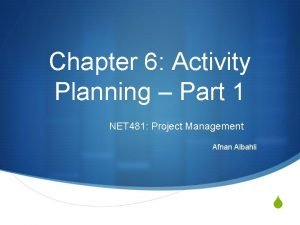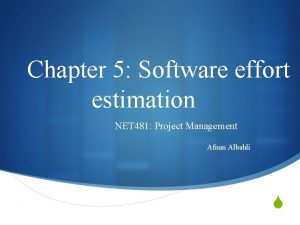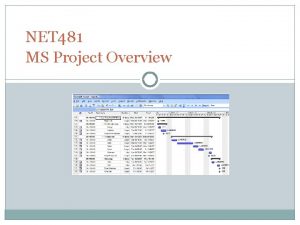Chapter 6 Activity Planning Part 2 NET 481



















- Slides: 19

Chapter 6: Activity Planning – Part 2 NET 481: Project Management Afnan Albahli S

Identifying Activities There are three approaches to identify the activities or tasks that will make up the project: S The activity-based approach. S The product-based approach. S The hybrid-based approach.

The activity-based approach The activity based approach consists of creating a list of all activities that the project is thought to involve. How? S Brainstorming session involving the whole project team S The analysis of similar past projects. S One useful way is to divide you projects into stages and think what activities might be required at each stage. On way of creating the activity or task list is to create WBS (Work Breakdown Structure).

The activity-based approach (cont’d)

The activity-based approach (cont’d) In WBS we: S Identify the main (high level) tasks (activities) required to complete a project. S Then break each of these down into a set of lower-level tasks.

The activity-based approach (cont’d) When preparing the WBS: S Too great depth should be avoided. Why? S Will result in a large number of tasks that will need to be managed. S Too shallow structure should be avoided. Why? S This will provide insufficient detail for project control.

The activity-based approach (cont’d) Advantages (WBS) S More likely to obtain a task catalogue that is: S Complete and ﻛﺎﻣﻠﺔ S Composed of non-overlapping tasks ﻏﻴﺮ ﻣﺘﺪﺍﺧﻠﺔ S WBS represents a structure that can be refined as the project proceeds. S Early in the project, It can start shallow. ﻓﻲ ﺍﻟﺒﺪﺍﻳﺔ ﻣﺒﺴﻂ S Developed as information becomes available e. g. during project analysis and specification phases. ﻻﺣﻘ ﺑﺘﻔﺎﺻﻴﻞ ﺃﻜﺒﺮ Once the project activities have been identified (whether using the WBS or not) they will need to be sequenced.

The product-based approach It consists of producing a product breakdown structure PBS, and a product flow diagram PFD. S Product Breakdown Structure (PBS) S To show a system can be broken down into different products for development. S Advantage: It is less likely to omit a product.

The product-based approach (cont’d) S Product Flow Diagram (PFD) S Once a product breakdown structure has been created, work can then begin on creating a product flow diagram which identifies the order of precedence of products and will typically include multiple and complex parallel paths.

PBS

PFD

The hybrid-based approach S A mix of the activity-based approach and the product- based approach. S Most commonly used approach. The “WBS” in the hybrid approach is based on: S a list of the deliverable products of the project; and S a list of activities for producing each product.

The hybrid-based approach (cont’d)

Network Planning Models: are project scheduling techniques that model project activities and their relationships as a network. S Activity-on-Arrow techniques: S CPM (critical path method). S PERT (program evaluation review technique). S Activity-on-Node techniques: S Precedence Networks. These three methods are very similar and many people use CPM to refer to all of them.

Precedence Networks S In the precedence networks: S The nodes represent activities. S The lines between nodes represent dependencies.

Precedence Networks (cont’d) Rules and Conventions • A project network should have only one start node. • A project network should have only one end node. • A node has duration. • Links have no duration. • Precedents are referred to the immediate preceding activities. • Time moves from left to right. • A network may not contain loops. • A network should not contain dangles.

Precedence Networks (cont’d) Loops can't be directly represented in a project network. S If you know the number of times we expect to repeat a set of activities, then S we can draw them in a sequence repeating them for the appropriate number of times.

Precedence Networks (cont’d) A dangle: Here what is meant by the diagram is: that the project will be finished once we “the program has been installed” and “the user manual is written”. “Write user manual” is a dangling activity.

Precedence Networks (cont’d) S resolving the dangle
 Liedboek 481
Liedboek 481 Csce 481
Csce 481 Cpsc 481
Cpsc 481 Prototype 2 reddit
Prototype 2 reddit Csce 481
Csce 481 Chapter 12 lesson 2 improving your fitness
Chapter 12 lesson 2 improving your fitness Chapter 12 lesson 3 planning a personal activity program
Chapter 12 lesson 3 planning a personal activity program Chapter 4 physical activity for life
Chapter 4 physical activity for life Reactants products and leftovers
Reactants products and leftovers Debye huckel limiting law
Debye huckel limiting law What is aoa and aon
What is aoa and aon Form content and use
Form content and use Activity 2 finding the sequence
Activity 2 finding the sequence Activity 2 identifying the pattern
Activity 2 identifying the pattern Activity 2;
Activity 2; Art-labeling activity: the male reproductive system, part 1
Art-labeling activity: the male reproductive system, part 1 Activity part 3
Activity part 3 Quan hi
Quan hi Part part whole addition
Part part whole addition Unit ratio definition
Unit ratio definition




































